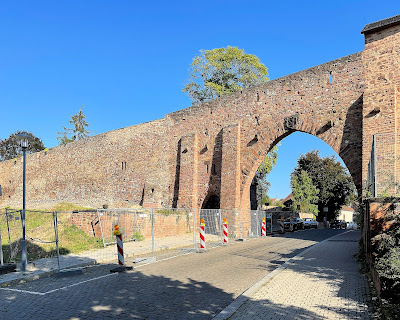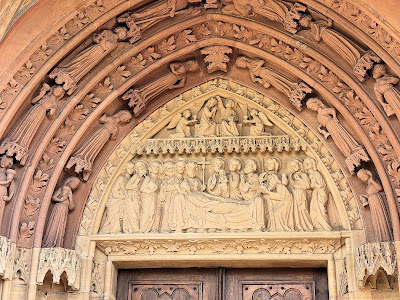My readers will be spoiled with a blog trilogy dealing with
- Worms and its churches,
- the exhibition "Here I stand" commemorating the 500th anniversary of Luther appearing in front of Emperor Charles V and the seven Electors at the 1521 Imperial Diet at Worms,
- the Jewish life in Worms, a place that belonged to the three SchUM cities.
Around Christ's birth, Worms was a Roman military base that existed until 85 AD. An associated civilian settlement developed urban structures and became known as Civitas Vangionum.

|
| Still visible today: The old city wall |
The actual starting point of Worms was constructing a city wall and a cathedral in Romanesque style.

|
| Bishop Burchard of Worms. Statue near the cathedral. |
Bishop Burchard
had the old cathedral from Merovingian times demolished and built a new,
much larger structure on the old foundations. Following the collapse of this
Worms cathedral, it was quickly rebuilt. It was consecrated in 1018 in the presence of Emperor
Henry II, still during Burchard's lifetime,
But Burchard's new cathedral had structural damage.

|
| The new, new Worms Cathedral in Romanesque style |
So his successor Bishop,
Burchard II, had the Burchard I cathedral demolished and started a completely new building from
scratch in 1130.

|
| Our guide explains the details of the cathedral standing behind a bronze model. |
This construction was consecrated in 1181 and still impresses the visitor.

|
|
The visitors' south entrance |

|
| The mighty west choir from the outside |

|
| The west choir from the inside |

|
|
Annunciation of Our Lady. God the Father above all. On the left is St.
Paul. On the far-out right, carpenter Joseph, the Child's foster father |

|
|
The Tree of Jesse with Mary and the Child on top. St.Peter, Bishop Burchard, and St.Paul venerate the messianic tree. Note: Most of Jesse's descendants wear crowns and no Jewish hats. |

|
| The Nibelungen portal |
A pivotal episode from the Saga of the Nibelungs occurred at the north
portal of Worms Cathedral with the Queen's Quarrel. According to the legend,
the rivals Brünhild and Kriemhild were arguing about which of their husbands
had the higher rank and which of the two queens was allowed to enter the
cathedral first.

|
|
Entrance to the St. Nicolas chapel The tympanum shows scenes of the saint's life. Still today, many children expect their treats on Nicolas Eve |

|
|
The altar of the chapel. St. Nicolas to the left, and the man with the gridiron, St. Lawrence to the right frame St. Mary with the Child. Note the modern stained glass. |

|
| Published in Popular Mechanics |
According to official figures, 559 people were killed or remained
missing due to the explosion, and another 1977 were injured. The
detonations damaged buildings as far as 75 km from the accident
site and could be heard as far away as Munich and Zurich. In terms of
the number of victims, it was the most significant accident in the
history of the German chemical industry to date and the most significant civil
explosion disaster in Germany.
During the nuclear age, some people looked at the stained glass window
and took offense at depicting the nearby Biblis nuclear power plant
(now decommissioned) as a modern "Tower of Bablis."

|
| St. Martin in the evening sun. |
In the evening, our group visited St. Martin, another Romanesque church.
There we were treated to an orgue concert performed by Freiburg's Minster organist, one of the participants in the excursion.

|
| Via Sancti Martini |
Red Baron knew about the Pilgrims' Road of St. James but learned
about the Via Sancti Martini at Worms. Allegedly St. Martin of Tours was
incarcerated at Wormatia in 396 because, when facing the Roman emperor, he
refused military service.
Aren't there any churches built in the Gothic style at Worms?

|
| Church of Our Lady (Liebfrauenkirche) |
Way out in the vineyards - the Liebfrauenmilch (Beloved lady's
milk) is one of the cheap sweet German wines - we visited the Church of
our Lady, built as a pilgrims' church and finished in 1465. The French
Wikipedia calls the building the most important Gothic church between
Strasbourg and Cologne.

|
| The tympanum shows the death and coronation of St. Mary |

|
| The sanctuary |

|
|
Modern stained glass (see above) showing the multiplication of the loaves. |

|
|
No, this is not St. Mary with the Child but Anna Selbdritt (St. Anna with daughter Mary and baby son Jesus) The baby got lost. |

|
| On the outside |
A weathered pieta on the war memorial for the fallen of the First
World War. The inscriptions read, "They became strong and were
prepared to die for their laws and homeland" (2 Macc 8.21) and "They
receive great honor and an everlasting name" (1 Macc 2.51 and not
8.7).
Dulce et decorum est pro patria mori?
Never again.
*

No comments:
Post a Comment